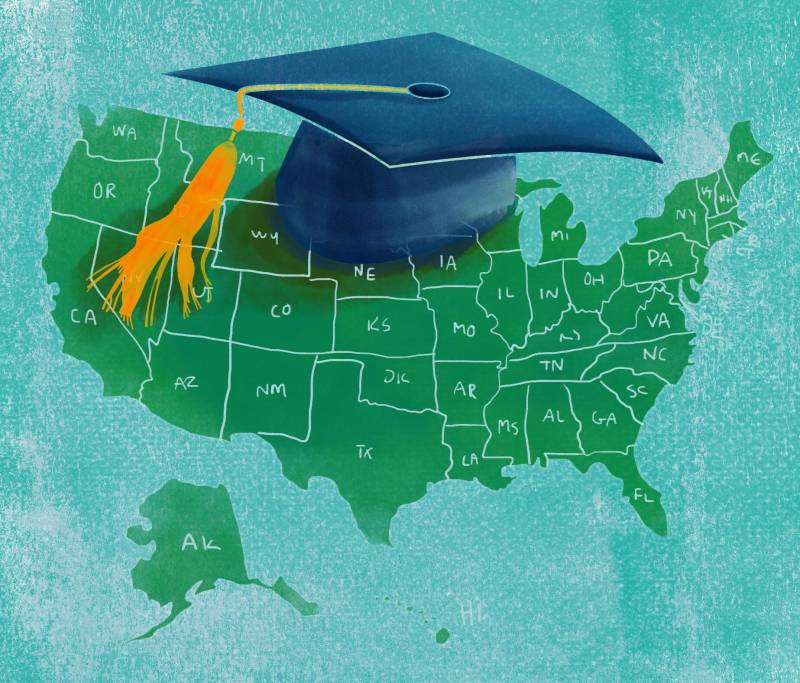Low-Performing Students Fall Farther Behind the Pack
The alarming gap in NAEP reading achievement levels calls for a strategic, scientific response The post Low-Performing Students Fall Farther Behind the Pack appeared first on Education Next.


On January 29, the National Assessment of Education Progress, NAEP, released results from its 2024 assessment. This latest installment of the self-styled “Nation’s Report Card” makes depressing reading. Indeed, if it weren’t for bad news, there would be hardly any news at all.
The previous 2022 NAEP results were bad—but they could be blamed on the immediate effects of the pandemic. The 2024 results can help us assess the extent to which the sharp fall in performance in 2022 was transitory (like inflation was supposed to be). Unfortunately, the reality is that the decline continues.
One pattern evident in NAEP 2024, also seen in 2022, is that the lowest performing students are falling further behind. Consider the NAEP results for grade 4 reading (the patterns repeat for the other “big four” tests: grade 8 reading and grades 4 and 8 math).
Figure 1 charts out the percent of American students who are “below basic” and those that are “at or above proficient.” According to the National Assessment Governing Board, “basic” denotes partial mastery of the knowledge and skills that are fundamental for proficient work at each grade. Here’s a concrete example of what this means: students at the basic level in grade 4 should be able to sequence or categorize events from a literary text. Many students cannot even do that and are classified as “below basic”.
“Proficient” represents solid academic performance: “Students reaching this level have demonstrated competency over challenging subject matter, including subject-matter knowledge, application of such knowledge to real-world situations, and analytical skills appropriate to the subject matter.” Grade 4 students reaching the proficient level should be able to describe the impact of a character’s actions or explain how characters influence one another.
The figure displays trends going back a little more than a decade in the percent of American 4th graders who fall at the two ends of the NAEP achievement levels: those who are below basic and those who meet (or exceed) proficiency standards.
A Widening Gap (Figure 1)
The share of 4th-grade students who have scored “below basic” on the NAEP reading assessment has grown dramatically since before the pandemic. Conversely, the share of high-achieving students who have scored in the “proficient” category has dropped five points since 2019.

Source: National Center for Education Statistics
Rather than seeing any recovery, the share of students below basic is 40 percent, up from 34 percent in pre-pandemic 2019 and 37 percent in 2022.
On the other end of the spectrum, the share of students who meet NAEP’s proficiency standards fell from 35 percent in 2019 and 33 percent in 2022 to 30 percent in 2024. There are now more 4th grade students below basic than there are students who are proficient. In short, rather than seeing any rebound in student achievement, the nation continues to slide.
Figure 2 provides further insight on the extent of this decline by looking at the below basic performance of subgroups of students. Let’s start with the largest group of students: the 60 percent or so of students eligible for free or reduced-price lunch (FRPL), a traditional measure of economic disadvantage. About half of these students are performing at the below basic level, a percentage that has been steadily increasing since 2015.
“Below Basic” on the Rise (Figure 2)
A decade ago, the share of students who scored “below basic” in the subgroups of free and reduced-price lunch, Black, and Hispanic was below 50 percent. By 2022, all three student subgroups surpassed that threshold.

Source: National Center for Education Statistics
Black students, who make up about 15 percent of American students, are heavily represented in the below basic category at grade 4: well over half of Black students are below basic—a percentage that has likewise climbed steadily since 2015. Half of all Hispanic students, who comprise about 23 percent of American students, are in the below basic category. About 15 percent of American students are classified as having a disability. Of all four groups, they have the highest concentration of scores in the below basic category: around 70 percent.
The NAEP results make clear the failure of American schools to rebound from Covid. And despite the infusion of over $180 billion in federal money to rescue American schools since the pandemic, there is no evidence of a turnaround.
EdNext in your inbox
Sign up for the EdNext Weekly newsletter, and stay up to date with the Daily Digest, delivered straight to your inbox.
Remember that this decline in reading proficiency at 4th grade has knock-on effects throughout a child’s education. Remember, too, that the nation has invested countless dollars and years in studying the science of reading. Indeed, there is probably no other subject in which the science is better. But the nation wasted years and years pursuing ineffective approaches to teaching reading, including Lucy Calkins’s Units of Study and the “guided reading” system of Fountas and Pinell.
States are finally pushing back against this junk science and demanding that their reading instruction be based on the science of reading. (It is hard to overstate just how important the work of Emily Hanford and her “Sold a Story” podcast has been in driving this effort.)
But the Institute of Education Sciences (IES), the nation’s premier education science agency, has not done its part. In the mid-2000s, motivated in part by the work of the National Reading Panel, the Institute launched one of its largest and most focused efforts: Reading for Understanding. This initiative spent around $130 million (around $250 million in today’s dollars) and helped lay a strong foundation for the science of reading. It was launched because of stagnant literacy rates in the nation and was based on the belief that the science of reading had progressed far enough to justify such a large investment.
If the stagnation of literacy rates in the mid-2000s was worrying enough to propel such a concerted effort, today’s falling literacy rates should be even more worthy of strategic intervention. To be sure, our understanding of the science of reading is far stronger 20 years later.
The culture of IES research centers supports “field-initiated research,” spreading its limited research dollars over many different topic areas. In 2024, IES’s National Center for Education Research spent over $100 million mostly on a series of “one-off” research projects spread over more than a dozen topic areas. Rather than coordinate projects to accomplish a mission-critical goal (such as halving the percentage of students scoring below basic in reading over the next five years), the center prioritized supporting research put forward by academic researchers, all too often reflecting their own interests rather than America’s needs.
Perhaps it’s time to launch another national reading panel, like the one that ran between 1997 and 2000. But we don’t have time to waste. We already know enough to refashion our approach to reading research. IES should launch a coordinated, large-scale research program focused on strengthening the foundations of literacy and on making sure that effective literacy programs are implemented. That coordinated research program should be positioned for maximum impact on America’s students, not at maximally supporting academic researchers producing obscure articles published in obscure journals.
Mark Schneider was the Director of the Institute for Education Science from 2018 through March 2024. He is a non-resident senior fellow at the American Enterprise Institute.
The post Low-Performing Students Fall Farther Behind the Pack appeared first on Education Next.



















_Daniel_Lamborn_Alamy.jpg?#)























































